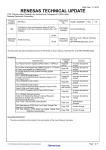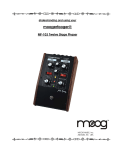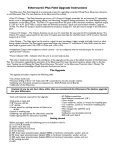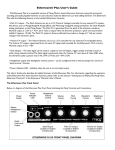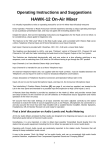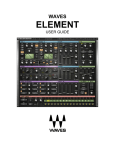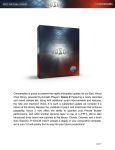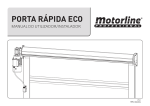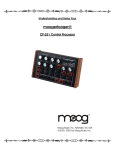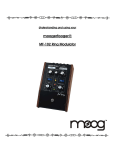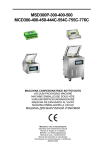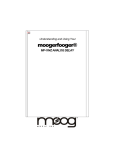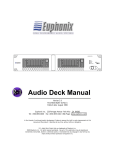Download MF-101 Lowpass Filter
Transcript
Understanding and using your moogerfooger® MF-101 Lowpass Filter Welcome to the world of moogerfooger® Analog Effects Modules! Your Model MF101 Lowpass Filter is a rugged, professional-quality instrument, designed to be equally at home on stage or in the studio. Its great sound and classic effects come from the state-of-the-art all-analog circuitry, designed and built under Bob Moog's personal direction. Your MF-101 is a direct descendent of the original modular Moog™ synthesizers. It contains two complete modular functions: a Voltage-Controlled Lowpass Filter and an Envelope Follower. All performance parameters are voltage-controllable, which means that you can use expression pedals, MIDI-to-CV converter, or any other source of control voltages to 'play' your MF-101. While you can use it on the floor as a conventional effects box, your MF-101 is much more versatile and its sound quality is higher than the single fixed function "stomp boxes" that you're probably accustomed to. You will find that your MF-101 is a deep musical resource. It will give you an amazing variety of new sounds and will become your creative companion as you explore its functions. The following pages will first tell you how to hook up your MF-101 and set the panel controls for the 'basic' setup. Next, we'll explain how the modular functions in your MF101 work. After that we'll give you some suggestions on how to use your MF-101 in specific applications. At the end of this booklet you'll find technical specifications, service and warranty information. GETTING STARTED Here are some simple instructions on how you can quickly plug in and try out your MF101. 1. Unpack your MF-101. You can place it on a table or on the floor. We suggest that you place it on a table while you become familiar with its features. 2. Check that the power adaptor is rated at your country's standard power voltage (120 volts A.C. for the United States and Canada; 100 volts AC for Japan; and 220 volts A.C. for most other countries). Plug the power adaptor's cord into the MF-101's '+9V' jack. Then plug the power adaptor itself into a power voltage receptacle. 3. Note that the BYPASS light is on. It will light up either red or green. Red indicates that the MF-101's filter is off-line (bypassed), while green indicates that the filter is on-line. Pressing the 'stomp switch' will toggle the BYPASS light between red and green. For now, leave the BYPASS light on red. 4. Connect an instrument cable from the MF-101 AUDIO OUT jack to a line-level input of your amp or mixer. Turn the volume control on your amp down but not off. 5. You can feed virtually any instrument-level or line-level signal through your MF-101. Examples are guitar, bass, keyboard, theremin, drum machine, or Effects Send output on your mixer. Connect an instrument cable from your signal source to the MF-101 AUDIO IN jack. Play your instrument (or turn on the signal source). Turn the DRIVE control clockwise until the LEVEL indicator lights up yellow most of the time. 6. The BYPASS light should still be red. Continuing to play your instrument, adjust the volume control of your monitor amp until the loudness is comfortable. Your instrument should sound clean and undistorted. 7. Now set the MF-101 panel controls as follows: MIX CUTOFF RESONANCE AMOUNT Left Switch Right Switch 10 250 6 6 SMOOTH 4-POLE Press the stomp switch. The BYPASS light will now turn green. Play your instrument. Your instrument's signal is now going through the filter. Listen to how the filter affects the quality of your instrument's tone. Note also that louder tones 'open' the filter more than softer tones. 8. In the next section we'll explain exactly what the filter and envelope follower do and how the controls work. For now, get a feel for the controls by experimenting with different settings HOW A LOWPASS FILTER WORKS Let's start with some definitions, so we're all talking the same language. Sound is a vibration of the air. The speed of vibration is called the frequency. It is measured in Hertz (Hz). One Hz is one vibration per second. We hear vibrations from 20 Hz to 20,000 Hz. Musical sounds generally have many frequency components. They're called harmonics, or overtones, or partials. They are what give the sound its characteristic tone color, or timbre. This “spectrum” graph shows the strengths of the harmonics in a sound. A filter allows some frequencies to pass and cuts off other frequencies. A Lowpass Filter is a kind of filter that allows all frequencies up to a certain frequency to pass, and cuts off frequencies above that. That frequency is called the cutoff frequency of the filter. We'll call it "the cutoff" for short. A lowpass filter removes the high frequencies from a tone. It makes the tone more mellow or muted. The lower the cutoff, the more muted the tone sounds. Imagine a window shade. As it is pulled down, it cuts out the higher light, then the light from the middle of the window, then finally all the light. A lowpass filter does the same sort of thing with the sound spectrum. This “frequency response” graph shows that the gain of a lowpass filter drops off at frequencies above the cutoff frequency. Your MF-101 contains a genuine classic four-pole lowpass filter. This kind of filter was first patented by Bob Moog in 1968. It is a big part of the 'Moog Sound' of the '60's and '70's. The effect has been imitated, but never equaled, by many instrument manufacturers. Your MF-101 also contains a classic envelope follower. An envelope follower tracks the loudness contour (envelope) of a sound, and produces a voltage that follows the dynamics of your playing. Every time you play a note, the envelope voltage goes up and then down. The harder you play, the higher the envelope voltage goes. The Envelope signal follows the amplitude (loudness) of the sound which it represents. The envelope follower output opens and closes the lowpass filter. Think of the envelope voltage as an invisible hand that turns the CUTOFF knob up and down every time you play a note. Since the envelope follows the dynamics of your instrument's signal, you actually 'play' the filter as you play your instrument. TOURING THE PANEL FEATURES The Filter Section Let's look at the Filter section first. The two control knobs are CUTOFF and RESONANCE. The 2-POLE 4-POLE switch selects the filter’s operating mode. All three of these affect the sound of the filter. The CUTOFF knob opens and closes the filter. As we said above, the filter lets through the low overtones and cuts off the higher overtones. As the filter closes, more and more of the high overtones are cut off. The CUTOFF knob is calibrated in Hz. (vibrations per second). The cutoff frequency is about 15 Hz when the knob is counterclockwise, 500 Hz (about an octave above middle C) when the knob is in mid-position, and 12 kHz, (12,000 vibrations per second) when the knob is clockwise. The RESONANCE knob changes the way the filter sounds. Or, in technical words, it changes the shape of the frequency response. When RESONANCE is near 0 the low overtones come through evenly. When RESONANCE is turned up to around 7, the overtones near cutoff will be boosted, creating a whistle-like or vowel-like quality. When RESONANCE is above 8, the filter actually produces its own tone at the cutoff frequency. That tone interacts with your instrument's tone when you play your instrument through the filter. The 2-POLE 4-POLE switch selects whether the signal goes through half the filter (2pole) or the entire filter (4-pole). 2-POLE has a bright sound, while 4-POLE has a deeper, mellow quality. The Envelope Follower Section The AMOUNT knob, the SMOOTH-FAST switch, and the ENV light are all part of the Envelope Follower section. The AMOUNT knob determines how much the envelope signal is used to open and close the filter. When the knob is counterclockwise, the envelope signal has no effect on the filter. When the knob is clockwise, the envelope signal opens and closes the filter as much as five octaves. The SMOOTH-FAST switch determines whether or not the envelope signal is smoothed out. Some sounds (like guitar chords) have long, rough envelopes, and they often sound better if the envelope is smoothed out before going to the filter. Other sounds (like snare drum) are quick and sharp, and sound really good with the switch in the Fast position. The ENV light shows how strong the envelope signal voltage is at any one time. The stronger the audio input, the brighter the ENV light will be. Audio Input Level and Mixing The DRIVE and MIX controls and the LEVEL light are all part of the audio input level and mixing circuitry. The DRIVE control adjusts the input gain. With this control you can set the right input gain for virtually any instrument or line-level signal source. Turn this control counterclockwise for strong input signals, and clockwise for weaker sound sources. The DRIVE control is always active, even when the MF-101 is in BYPASS mode. The MIX control crossfades from the straight input signal to the filtered signal. Use this control to get any mixture of filtered and unfiltered sound. The LEVEL light tells how strong the input signal is after being adjusted by the DRIVE control. As the signal level increases, the light goes from off, to green, to yellow, and finally to red. Very weak signals do not light up this light at all. When the light is green, the signal is below the level that results in audible distortion. When the light is yellow, some low order distortion may be audible, giving the sound a subtle warm analog quality. When the signal is strong enough to drive the light into the red, the distortion at the output becomes stronger and more distinctly audible. Watch this light when you set the DRIVE control for the desired effect. Simplified Block Diagram of the MF-101 EXPRESSION PEDALS AND VOLTAGE CONTROL You now know what each of the rotary control knobs does to the sound of the MF101. With the exception of DRIVE, each knob has an expression pedal input which duplicates its effect. This enables you to plug in up to four expression pedals to play the MF-101 with your feet as well as with your hands. The moogerfooger EP-1 Expression Pedal is designed for this purpose. Or you can use expression pedals with equivalent specifications. See the Technical Information section on Page 12 for more information on pedal specifications. When you plug an expression pedal into one of the pedal inputs on your MF-101, the pedal adds to the effect of the corresponding control. For example, let’s say that you plug an expression pedal into your MF-101’s CUTOFF input. With the pedal all the way back, the cutoff frequency of the filter is set by the CUTOFF knob. Then, when you advance the pedal, the cutoff frequency of the filter goes up, just as if you turned the CUTOFF knob up. So, a good rule to follow is: when you use an expression pedal, you set the corresponding knob for the lowest value you want. Then, advancing the pedal increases that value. The expression pedal inputs can also be used as control signal inputs. This enables you to use your MF-101 with virtually any control signal source: modular analog synthesizers, MIDI-to-CV converters, etc. You will find information on interfacing your MF101 with external control signal sources in the Technical Information section on Page 12. Your MF-101 has one control signal output jack. It is labeled ENV OUT. It may be used as a control signal source to control other voltage-controlled devices, including other moogerfooger analog effects modules. The amplitude of the ENV OUT control signal is independent of the setting of the AMOUNT control or pedal. A WARNING! If you turn the RESONANCE knob past "8" , the filter in your MF-101 will oscillate. That is, it will produce a tone of its own. This is normal for a lowpass filter of this sort. In fact, synthesists have prized this effect for the past thirty years! However, you should be aware that it is possible to overheat your speakers if you set your MF-101 to oscillate and then leave it on a single frequency at high volume for an extended time. With no pedal connected to the CUTOFF jack, the oscillation frequency will be between 15 Hz and 12 kHz, depending on the setting of the CUTOFF knob. With a pedal or external control voltage plugged in to the CUTOFF jack, it is possible to drive the oscillating frequency up as high as 40 kHz! Some speaker systems, especially precision studio monitors or audiophile speakers, may be vulnerable to high-volume steady tones at some frequencies within the MF-101's range,- even frequencies that are too high or low to be audible! You can protect your speakers by being aware of your MF-101's output when the RESONANCE knob is at "8" or above. Switch your MF-101 to BYPASS when you are not actually playing it. ANOTHER WARNING! You'll find that your MF-101 sounds really good. You may be tempted to crank up the volume so you can really hear it. That's OK, as long as you keep a lid on those high frequencies (2 kHz and above) that will stress your ears if they're amplified too much. Like any high quality electronic musical instrument, your MF-101 is capable of producing a wide range of frequencies. It is up to you to use that frequency range in a careful and professional manner. SOME TYPICAL SETUPS Here are some nice setups to start off with. Experiment with all of them. Try changing the knob settings with your hands. Then plug in one or more expression pedals and try the same things with your feet. Guitar: Basic Lowpass Wah The expression pedal gives you extremely wide sweep range. AMOUNT = 0 MIX = 10 CUTOFF = 120 RESONANCE = 5 (normal wah); 7 (stronger wah) ENV SWITCH = Doesn’t matter MODE SWITCH = 2-POLE (brighter) or 4-POLE (more mellow) EXPRESSION PEDAL to the CUTOFF jack Guitar: Hyper-Punch This setup emphasizes your dynamics without producing strong coloration. It’s good for playing fast lead lines. The pedal brings the effect in and out. AMOUNT = 6 MIX = 10 CUTOFF = 250 RESONANCE = 0 (minimum coloration) to 6 (a little coloration) ENVELOPE SWITCH = FAST MODE SWITCH = 2-POLE (brighter); 4-POLE (more mellow) EXPRESSION PEDAL to AMOUNT, - or no pedal at all Guitar: Screaming Dynamic Wah The Resonance is turned way up. The filter produces its own tone which your instrument tears up. AMOUNT = 6 MIX = 10 CUTOFF = 120 RESONANCE = 7 (on the edge) to 9 (screaming) ENVELOPE SWITCH = SMOOTH MODE SWITCH = 2-POLE (brighter); 4-POLE (more mellow) EXPRESSION PEDAL to the CUTOFF jack Bass: Deep Dynamic Tuba-Wah The trick here is to turn the DRIVE control up far enough so that the LEVEL light is in the red while you're playing. At the same time, turn down the gain control on your amp. AMOUNT = 4 - 6 MIX = 10 CUTOFF = 60 - 120 RESONANCE = 0 - 2 for tuba sound; 6 - 7 for overdrive wah ENVELOPE SWITCH = SMOOTH MODE SWITCH = 2-POLE (brighter); 4-POLE (more mellow) EXPRESSION PEDAL to the CUTOFF jack Theremin or Sax: Talking Lead With RESONANCE turned up to 6 or 7, your instrument's sound has an expressive vocal quality as you play alternately loud and soft. With RESONANCE turned down, your instrument's brightness builds up and dies down as you play alternately loud and soft. Set your theremin's tone to maximum brightness. Check out the effects when your theremin is producing subsonic pitches. AMOUNT = 6 - 8 MIX = 10, - or set it to 0 with expression pedal to MIX CUTOFF = 250 - 500 , or set it to 60 with expression pedal to CUTOFF RESONANCE = 0 to 7, or set it to 0 with expression pedal to RESONANCE ENVELOPE SWITCH = SMOOTH MODE SWITCH = 2-POLE (brighter); 4-POLE (more mellow) Drum Machine: Synth Drums Keep the rhythm going while sweeping the CUTOFF and/or envelope AMOUNT. Also experiment with turning up the DRIVE. AMOUNT = 8 MIX = 10 CUTOFF = 60 - 500, RESONANCE = 6 - 8, or set it to 0 with expression pedal to RESONANCE ENVELOPE SWITCH = FAST for punchy effects; SMOOTH for whistling percussive effects MODE SWITCH = 2-POLE (brighter); 4-POLE (more mellow) TECHNICAL INFORMATION NOTE: The following information is intended for use by people who understand analog electronic circuitry and have enough practical experience to interconnect sophisticated electronic equipment correctly. POWER: The MF-101 works satisfactorily on +9 to +15 volts DC and uses about 100 milliamperes of current. If your power adaptor shows up missing or inoperative, you can power your MF-101 from any other power adaptor with a +9 volt or +12 volt rating and with the same power connector. If you use a power source other than that which was supplied with the MF-101, be sure that the voltage never exceeds +15 volts. Power voltages in excess of +15 volts may cause serious damage to the MF-101's circuit. PEDAL INPUTS: All pedal control input jacks are 1/4" tip-ring-sleeve phone jacks. The sleeves are grounded and the ring terminals are supplied with +5.7 volts which is current-limited to about 0.5 milliamperes. The tip terminals receive the variable voltages from the pedals. Correct wiring of an expression pedal for the MF-101. An expression pedal for use with the MF-101 should contain a 50KW or 100KW potentiometer which is connected from the sleeve to the ring terminals. The potentiometer wiper is connected to the tip terminal. The pedal cable should be shielded, with the shield connected to the sleeve terminal. When connecting one or more pedal control input jacks to a source of external control voltage such as an analog synth or a MIDI-to-CV converter, you should use patch cords with tip-ring-sleeve phone plugs. The ring terminal on the plug should not be connected to anything, so that the MF-101's source of +5.7 volts is not shorted out. Correct wiring of a tip-ring-sleeve plug for connecting a pedal control input to a source of external control voltage. Or, if you do not plan to use any expression pedals with your MF-101 but would like to apply control voltages to one or more pedal control inputs, you can use patch cords with regular two-conductor (tip-sleeve) phone plugs. These will short out the +5.7 volt supply to the ring contacts. This voltage is current-limited, so you won't burn anything out, - but no pedal will work in any of the pedal control jacks if a tip-sleeve plug is plugged into even one of the pedal jacks. Applying a varying voltage to the tip terminal of a pedal control input jack has the same effect as turning the corresponding knob. A voltage change of about 5 volts at the tip terminal is usually equivalent to turning the corresponding knob through its entire range. You can 'program' your MF-101 entirely from external control voltages, by turning all four control knobs (but not the DRIVE knob) counterclockwise, and feeding 0 to +5 Volt programming voltages to the tips of the four pedal control input jacks. AUDIO PATH: Both the bypassed and the filtered signals go through voltage-controlled amplifier circuits inside the MF-101. This is necessary to permit voltage-controlled mixing and smooth, clickless switching. As a result, the MF-101 will not pass an audio signal at all unless power is applied to it. Another result of this arrangement is that the strength of the audio output signal depends on the setting of the DRIVE control, even when the MF-101 is switched to BYPASS. The nominal audio output level with the LEVEL light in the yellow is about 0.5 volts RMS. LIMITED WARRANTY Moog Music warrants that its products will be free from defects in materials or workmanship, and shall conform to specifications current at the time of shipment, for a period of one year from date of purchase. During the one-year period, any defective products will be repaired or replaced, at Moog Music's option, on a return-to-factory basis. This Warranty covers defects that Moog Music determines are no fault of the user. RETURNING YOUR MF-101 FOR REPLACEMENT/REPAIR You must obtain prior approval and an RMA number from Moog Music before returning any product to us (call (828) 251-0090). Wrap your MF-101 carefully and pack it with the power adaptor in its original carton. The warranty will not be honored if the product is not properly packed. Then send it to Moog Music (UPS is recommended) with transportation and insurance charges paid. A reasonable cost for service and for materials and return freight will be charged to replace materials defective through the fault of the user, or for which the one year warranty period has expired. Transportation and insurance charges from Moog Music to your United States address, of products repaired or replaced under warranty, will be paid by Moog Music. Notes: MOOG MUSIC. Inc. 554C Riverside Drive Asheville, NC 28801 PHONE: (828) 251-0090 FAX: (828) 254-6233 EMAIL: [email protected] WEB ADDRESS: http://www.moogmusic.com MF-101 SPECIFICATIONS DESCRIPTION: Analog Effects Module incorporating two functions: a voltage-controlled lowpass filter and an envelope follower. FRONT PANEL FEATURES: CUTOFF rotary control, which varies the filter's cutoff frequency over a nine-octave range RESONANCE rotary control, which varies the shape of the filter's response, from pure lowpass to actual oscillation ENVELOPE AMOUNT rotary control, which adjusts the amount that the input signal's envelope sweeps the filter cutoff frequency MIX rotary control, which crossfades continuously from unfiltered to filtered audio DRIVE rotary control, which adjusts the gain of the audio input SMOOTH-FAST rocker switch, which chooses between smooth and fast envelope follower response 2-POLE 4-POLE rocker switch, which chooses between 2-pole (bright) and 4-pole (deep) filter frequency response. LEVEL , a three-color LED that is used to set the DRIVE control ENV, a LED that indicates the strength of the envelope voltage BYPASS, a two-color LED that tells whether the filter is on or bypassed ON/BYPASS, a rugged, smooth-acting 'stomp switch' JACK PANEL FEATURES: AUDIO IN 1/4" phone jack - accepts any instrument-level or line-level audio signal from 16 dBm to +4 dbm AUDIO OUT 1/4" phone jack - -4 dBm nominal output level CUTOFF, RESONANCE, AMOUNT, MIX, all of which are stereo 1/4" jacks that accept moogerfooger EP1 (or equivalent) expression pedals, or control voltages from either two-circuit or three-circuit 1/4" jacks. ENVELOPE OUT jack - delivers the Envelope Control voltage for use by other voltagecontrolled devices. +9V POWER INPUT jack - accepts standard 9 volt power adaptors (power adaptor included) GENERAL SPECIFICATIONS: CASE: Black panel with hardwood sides - classic analog appearance DIMENSIONS: 9" x 6" x 2-1/2" NET WEIGHT: 2 lb SHIPPING WEIGHT: 4 lb, including power adaptor and instruction manual POWER REQUIREMENTS: 110-120 volt, 5W. 220 volt power adaptor available on special order. MOOG MUSIC, Inc. 554C Riverside Drive Asheville, NC 28801 PHONE: (828) 251-0090 FAX: (828) 254-6233 EMAIL: [email protected] WEB SITE: http://www.moogmusic.com Entire Contents © 1998,2003 MOOG MUSIC Inc.















